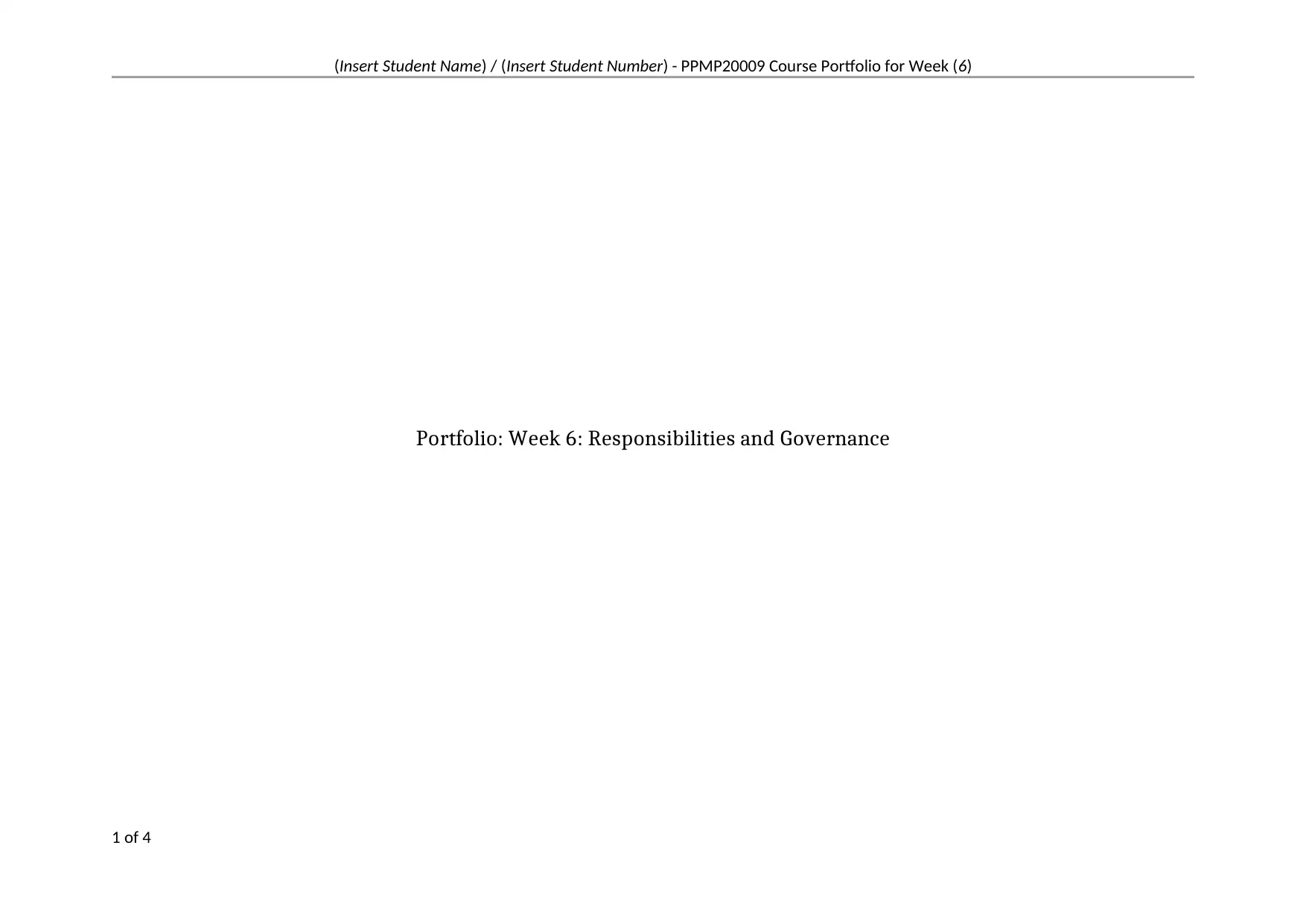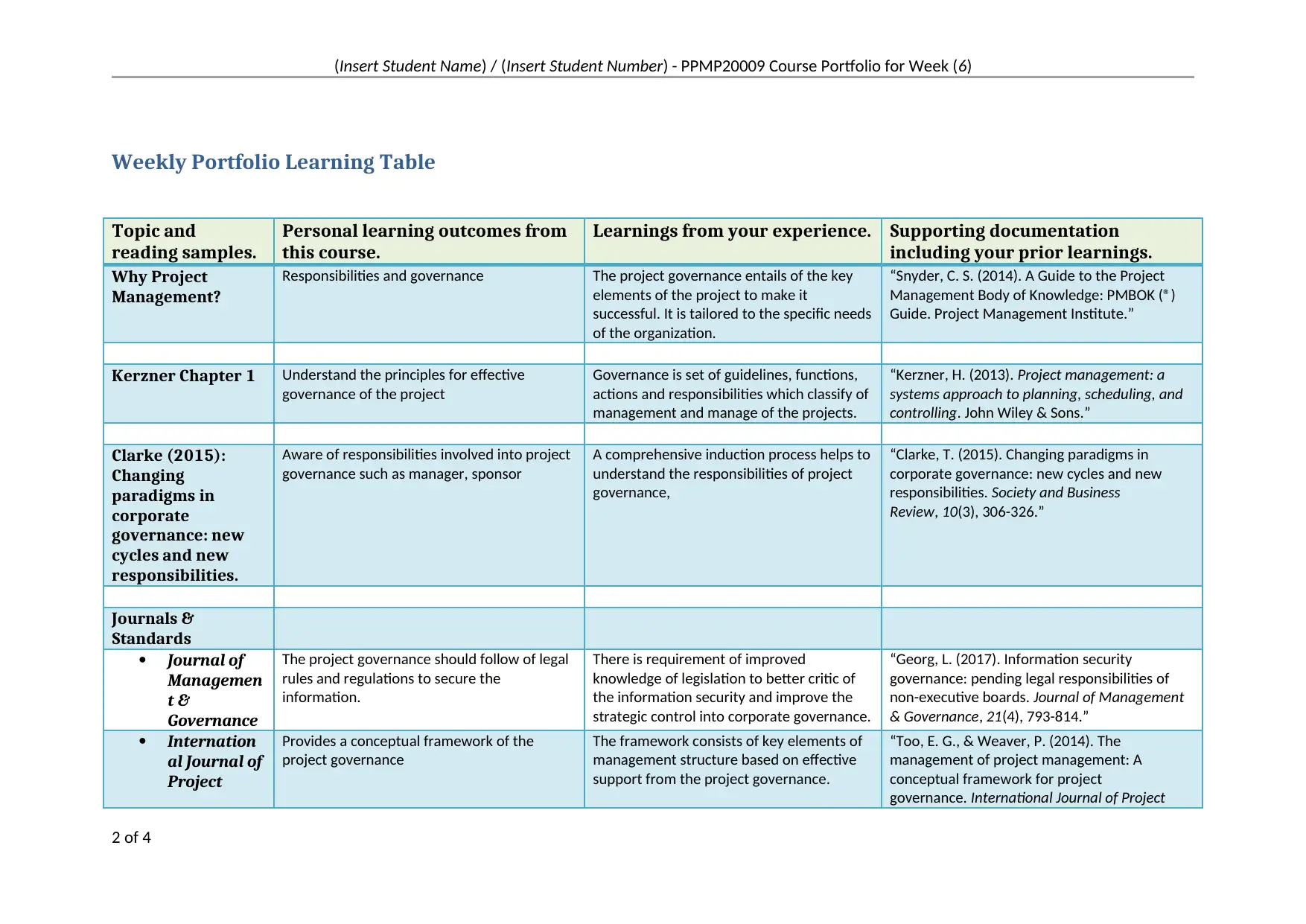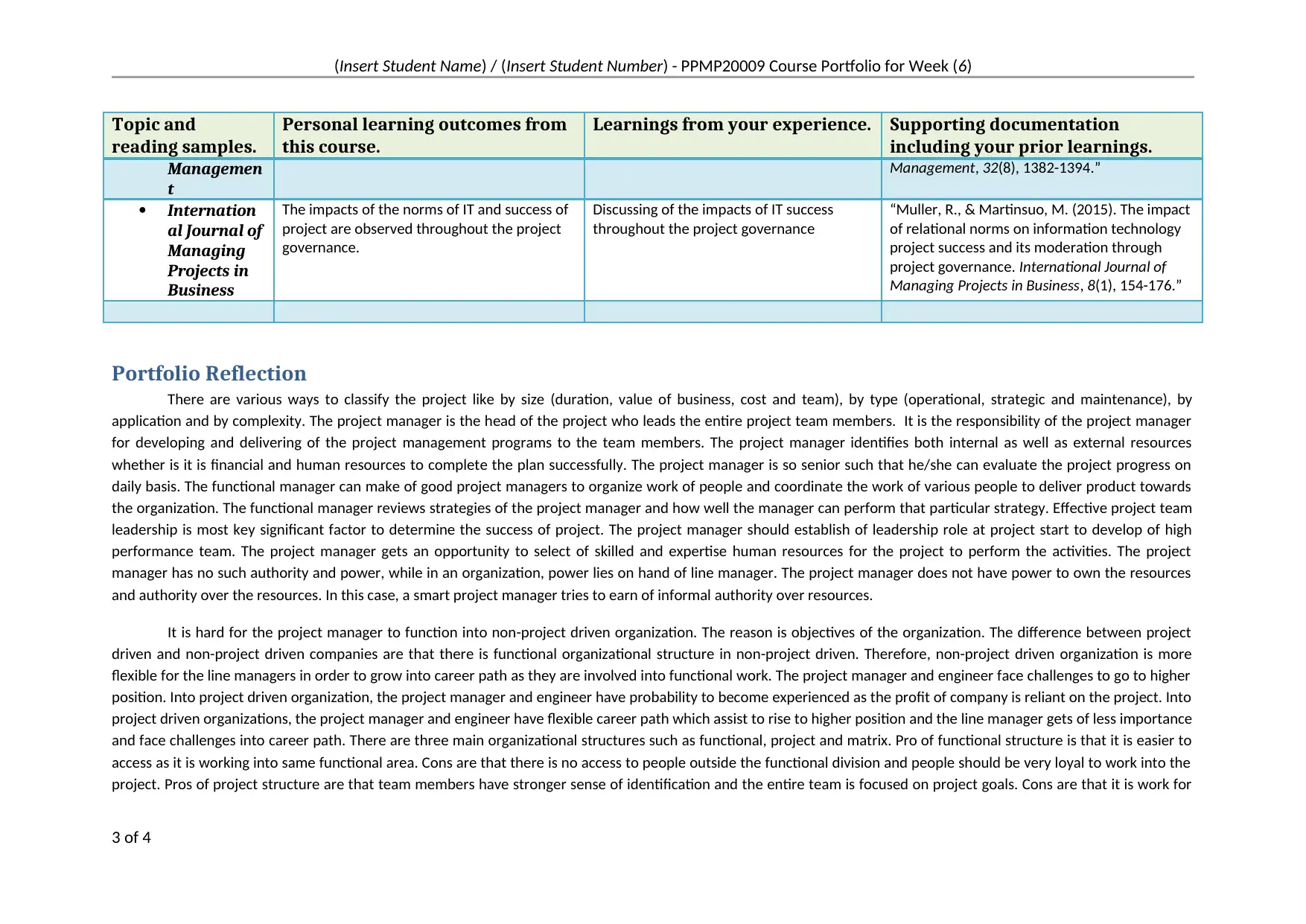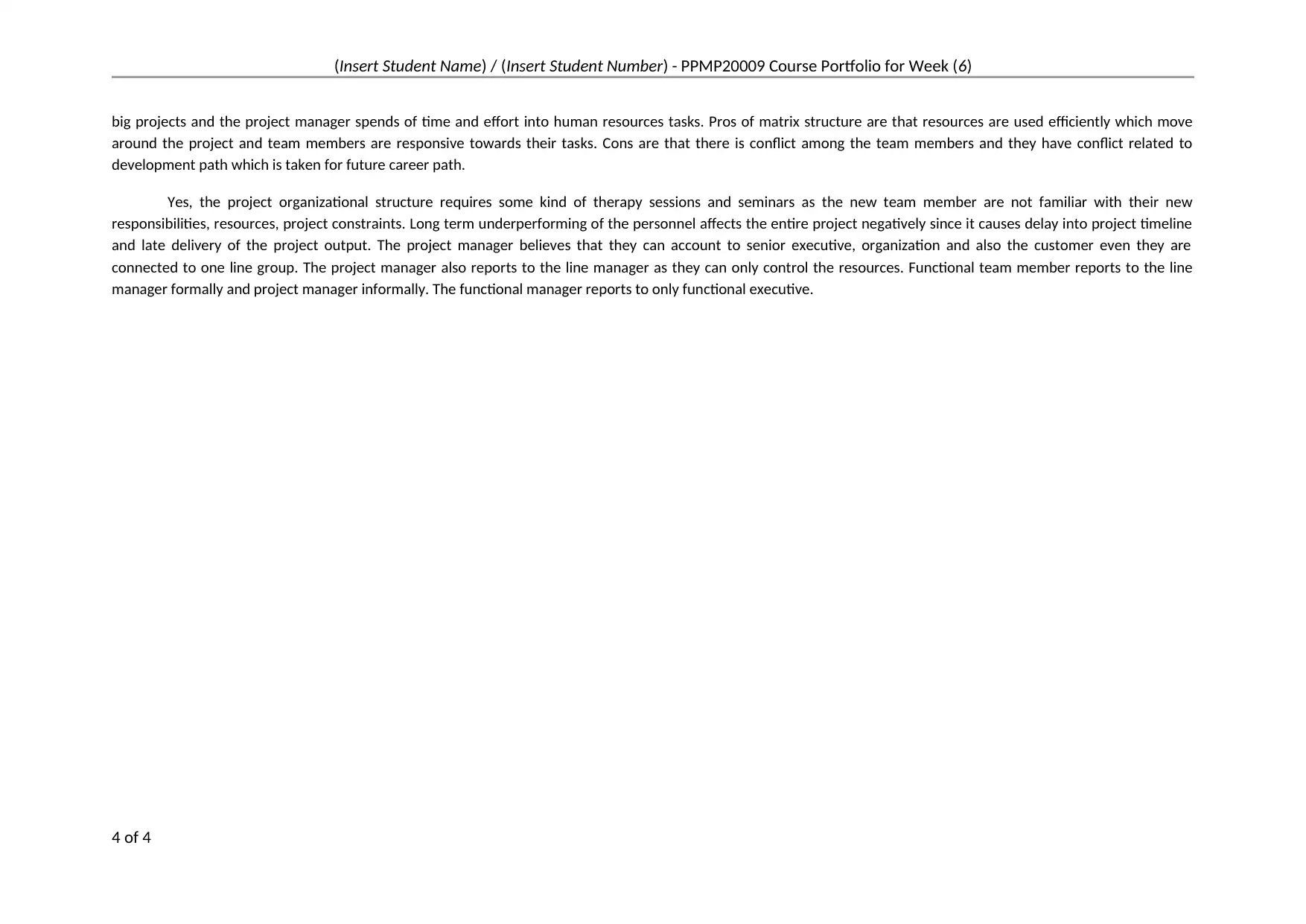PPMP20009 Portfolio: Week 6 - Responsibilities and Project Governance
VerifiedAdded on 2020/05/28
|4
|1194
|79
Project
AI Summary
This portfolio assignment, created for the PPMP20009 course, focuses on project governance and responsibilities. It explores key elements such as project governance, which involves guidelines, functions, and actions to ensure project success, tailored to organizational needs. The assignment references various sources including PMBOK Guide and Kerzner's work on project management. It also covers responsibilities of project managers, functional managers, and the impact of organizational structures (functional, project, and matrix) on project success and team dynamics. The portfolio includes reflections on project classifications, leadership, resource management, and the importance of clear roles and responsibilities for effective project delivery, along with the need for training to improve project management skills. The assignment analyzes the importance of project governance, the role of the project manager, and the impact of organizational structures on project success and team dynamics, and discusses the importance of team members understanding their responsibilities.

(Insert Student Name) / (Insert Student Number) - PPMP20009 Course Portfolio for Week (6)
Portfolio: Week 6: Responsibilities and Governance
1 of 4
Portfolio: Week 6: Responsibilities and Governance
1 of 4
Paraphrase This Document
Need a fresh take? Get an instant paraphrase of this document with our AI Paraphraser

(Insert Student Name) / (Insert Student Number) - PPMP20009 Course Portfolio for Week (6)
Weekly Portfolio Learning Table
Topic and
reading samples.
Personal learning outcomes from
this course.
Learnings from your experience. Supporting documentation
including your prior learnings.
Why Project
Management?
Responsibilities and governance The project governance entails of the key
elements of the project to make it
successful. It is tailored to the specific needs
of the organization.
“Snyder, C. S. (2014). A Guide to the Project
Management Body of Knowledge: PMBOK (®)
Guide. Project Management Institute.”
Kerzner Chapter 1 Understand the principles for effective
governance of the project
Governance is set of guidelines, functions,
actions and responsibilities which classify of
management and manage of the projects.
“Kerzner, H. (2013). Project management: a
systems approach to planning, scheduling, and
controlling. John Wiley & Sons.”
Clarke (2015):
Changing
paradigms in
corporate
governance: new
cycles and new
responsibilities.
Aware of responsibilities involved into project
governance such as manager, sponsor
A comprehensive induction process helps to
understand the responsibilities of project
governance,
“Clarke, T. (2015). Changing paradigms in
corporate governance: new cycles and new
responsibilities. Society and Business
Review, 10(3), 306-326.”
Journals &
Standards
Journal of
Managemen
t &
Governance
The project governance should follow of legal
rules and regulations to secure the
information.
There is requirement of improved
knowledge of legislation to better critic of
the information security and improve the
strategic control into corporate governance.
“Georg, L. (2017). Information security
governance: pending legal responsibilities of
non-executive boards. Journal of Management
& Governance, 21(4), 793-814.”
Internation
al Journal of
Project
Provides a conceptual framework of the
project governance
The framework consists of key elements of
management structure based on effective
support from the project governance.
“Too, E. G., & Weaver, P. (2014). The
management of project management: A
conceptual framework for project
governance. International Journal of Project
2 of 4
Weekly Portfolio Learning Table
Topic and
reading samples.
Personal learning outcomes from
this course.
Learnings from your experience. Supporting documentation
including your prior learnings.
Why Project
Management?
Responsibilities and governance The project governance entails of the key
elements of the project to make it
successful. It is tailored to the specific needs
of the organization.
“Snyder, C. S. (2014). A Guide to the Project
Management Body of Knowledge: PMBOK (®)
Guide. Project Management Institute.”
Kerzner Chapter 1 Understand the principles for effective
governance of the project
Governance is set of guidelines, functions,
actions and responsibilities which classify of
management and manage of the projects.
“Kerzner, H. (2013). Project management: a
systems approach to planning, scheduling, and
controlling. John Wiley & Sons.”
Clarke (2015):
Changing
paradigms in
corporate
governance: new
cycles and new
responsibilities.
Aware of responsibilities involved into project
governance such as manager, sponsor
A comprehensive induction process helps to
understand the responsibilities of project
governance,
“Clarke, T. (2015). Changing paradigms in
corporate governance: new cycles and new
responsibilities. Society and Business
Review, 10(3), 306-326.”
Journals &
Standards
Journal of
Managemen
t &
Governance
The project governance should follow of legal
rules and regulations to secure the
information.
There is requirement of improved
knowledge of legislation to better critic of
the information security and improve the
strategic control into corporate governance.
“Georg, L. (2017). Information security
governance: pending legal responsibilities of
non-executive boards. Journal of Management
& Governance, 21(4), 793-814.”
Internation
al Journal of
Project
Provides a conceptual framework of the
project governance
The framework consists of key elements of
management structure based on effective
support from the project governance.
“Too, E. G., & Weaver, P. (2014). The
management of project management: A
conceptual framework for project
governance. International Journal of Project
2 of 4

(Insert Student Name) / (Insert Student Number) - PPMP20009 Course Portfolio for Week (6)
Topic and
reading samples.
Personal learning outcomes from
this course.
Learnings from your experience. Supporting documentation
including your prior learnings.
Managemen
t
Management, 32(8), 1382-1394.”
Internation
al Journal of
Managing
Projects in
Business
The impacts of the norms of IT and success of
project are observed throughout the project
governance.
Discussing of the impacts of IT success
throughout the project governance
“Muller, R., & Martinsuo, M. (2015). The impact
of relational norms on information technology
project success and its moderation through
project governance. International Journal of
Managing Projects in Business, 8(1), 154-176.”
Portfolio Reflection
There are various ways to classify the project like by size (duration, value of business, cost and team), by type (operational, strategic and maintenance), by
application and by complexity. The project manager is the head of the project who leads the entire project team members. It is the responsibility of the project manager
for developing and delivering of the project management programs to the team members. The project manager identifies both internal as well as external resources
whether is it is financial and human resources to complete the plan successfully. The project manager is so senior such that he/she can evaluate the project progress on
daily basis. The functional manager can make of good project managers to organize work of people and coordinate the work of various people to deliver product towards
the organization. The functional manager reviews strategies of the project manager and how well the manager can perform that particular strategy. Effective project team
leadership is most key significant factor to determine the success of project. The project manager should establish of leadership role at project start to develop of high
performance team. The project manager gets an opportunity to select of skilled and expertise human resources for the project to perform the activities. The project
manager has no such authority and power, while in an organization, power lies on hand of line manager. The project manager does not have power to own the resources
and authority over the resources. In this case, a smart project manager tries to earn of informal authority over resources.
It is hard for the project manager to function into non-project driven organization. The reason is objectives of the organization. The difference between project
driven and non-project driven companies are that there is functional organizational structure in non-project driven. Therefore, non-project driven organization is more
flexible for the line managers in order to grow into career path as they are involved into functional work. The project manager and engineer face challenges to go to higher
position. Into project driven organization, the project manager and engineer have probability to become experienced as the profit of company is reliant on the project. Into
project driven organizations, the project manager and engineer have flexible career path which assist to rise to higher position and the line manager gets of less importance
and face challenges into career path. There are three main organizational structures such as functional, project and matrix. Pro of functional structure is that it is easier to
access as it is working into same functional area. Cons are that there is no access to people outside the functional division and people should be very loyal to work into the
project. Pros of project structure are that team members have stronger sense of identification and the entire team is focused on project goals. Cons are that it is work for
3 of 4
Topic and
reading samples.
Personal learning outcomes from
this course.
Learnings from your experience. Supporting documentation
including your prior learnings.
Managemen
t
Management, 32(8), 1382-1394.”
Internation
al Journal of
Managing
Projects in
Business
The impacts of the norms of IT and success of
project are observed throughout the project
governance.
Discussing of the impacts of IT success
throughout the project governance
“Muller, R., & Martinsuo, M. (2015). The impact
of relational norms on information technology
project success and its moderation through
project governance. International Journal of
Managing Projects in Business, 8(1), 154-176.”
Portfolio Reflection
There are various ways to classify the project like by size (duration, value of business, cost and team), by type (operational, strategic and maintenance), by
application and by complexity. The project manager is the head of the project who leads the entire project team members. It is the responsibility of the project manager
for developing and delivering of the project management programs to the team members. The project manager identifies both internal as well as external resources
whether is it is financial and human resources to complete the plan successfully. The project manager is so senior such that he/she can evaluate the project progress on
daily basis. The functional manager can make of good project managers to organize work of people and coordinate the work of various people to deliver product towards
the organization. The functional manager reviews strategies of the project manager and how well the manager can perform that particular strategy. Effective project team
leadership is most key significant factor to determine the success of project. The project manager should establish of leadership role at project start to develop of high
performance team. The project manager gets an opportunity to select of skilled and expertise human resources for the project to perform the activities. The project
manager has no such authority and power, while in an organization, power lies on hand of line manager. The project manager does not have power to own the resources
and authority over the resources. In this case, a smart project manager tries to earn of informal authority over resources.
It is hard for the project manager to function into non-project driven organization. The reason is objectives of the organization. The difference between project
driven and non-project driven companies are that there is functional organizational structure in non-project driven. Therefore, non-project driven organization is more
flexible for the line managers in order to grow into career path as they are involved into functional work. The project manager and engineer face challenges to go to higher
position. Into project driven organization, the project manager and engineer have probability to become experienced as the profit of company is reliant on the project. Into
project driven organizations, the project manager and engineer have flexible career path which assist to rise to higher position and the line manager gets of less importance
and face challenges into career path. There are three main organizational structures such as functional, project and matrix. Pro of functional structure is that it is easier to
access as it is working into same functional area. Cons are that there is no access to people outside the functional division and people should be very loyal to work into the
project. Pros of project structure are that team members have stronger sense of identification and the entire team is focused on project goals. Cons are that it is work for
3 of 4
⊘ This is a preview!⊘
Do you want full access?
Subscribe today to unlock all pages.

Trusted by 1+ million students worldwide

(Insert Student Name) / (Insert Student Number) - PPMP20009 Course Portfolio for Week (6)
big projects and the project manager spends of time and effort into human resources tasks. Pros of matrix structure are that resources are used efficiently which move
around the project and team members are responsive towards their tasks. Cons are that there is conflict among the team members and they have conflict related to
development path which is taken for future career path.
Yes, the project organizational structure requires some kind of therapy sessions and seminars as the new team member are not familiar with their new
responsibilities, resources, project constraints. Long term underperforming of the personnel affects the entire project negatively since it causes delay into project timeline
and late delivery of the project output. The project manager believes that they can account to senior executive, organization and also the customer even they are
connected to one line group. The project manager also reports to the line manager as they can only control the resources. Functional team member reports to the line
manager formally and project manager informally. The functional manager reports to only functional executive.
4 of 4
big projects and the project manager spends of time and effort into human resources tasks. Pros of matrix structure are that resources are used efficiently which move
around the project and team members are responsive towards their tasks. Cons are that there is conflict among the team members and they have conflict related to
development path which is taken for future career path.
Yes, the project organizational structure requires some kind of therapy sessions and seminars as the new team member are not familiar with their new
responsibilities, resources, project constraints. Long term underperforming of the personnel affects the entire project negatively since it causes delay into project timeline
and late delivery of the project output. The project manager believes that they can account to senior executive, organization and also the customer even they are
connected to one line group. The project manager also reports to the line manager as they can only control the resources. Functional team member reports to the line
manager formally and project manager informally. The functional manager reports to only functional executive.
4 of 4
1 out of 4
Related Documents
Your All-in-One AI-Powered Toolkit for Academic Success.
+13062052269
info@desklib.com
Available 24*7 on WhatsApp / Email
![[object Object]](/_next/static/media/star-bottom.7253800d.svg)
Unlock your academic potential
Copyright © 2020–2025 A2Z Services. All Rights Reserved. Developed and managed by ZUCOL.





